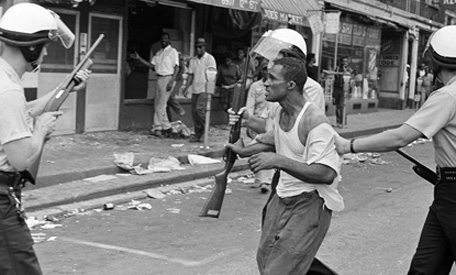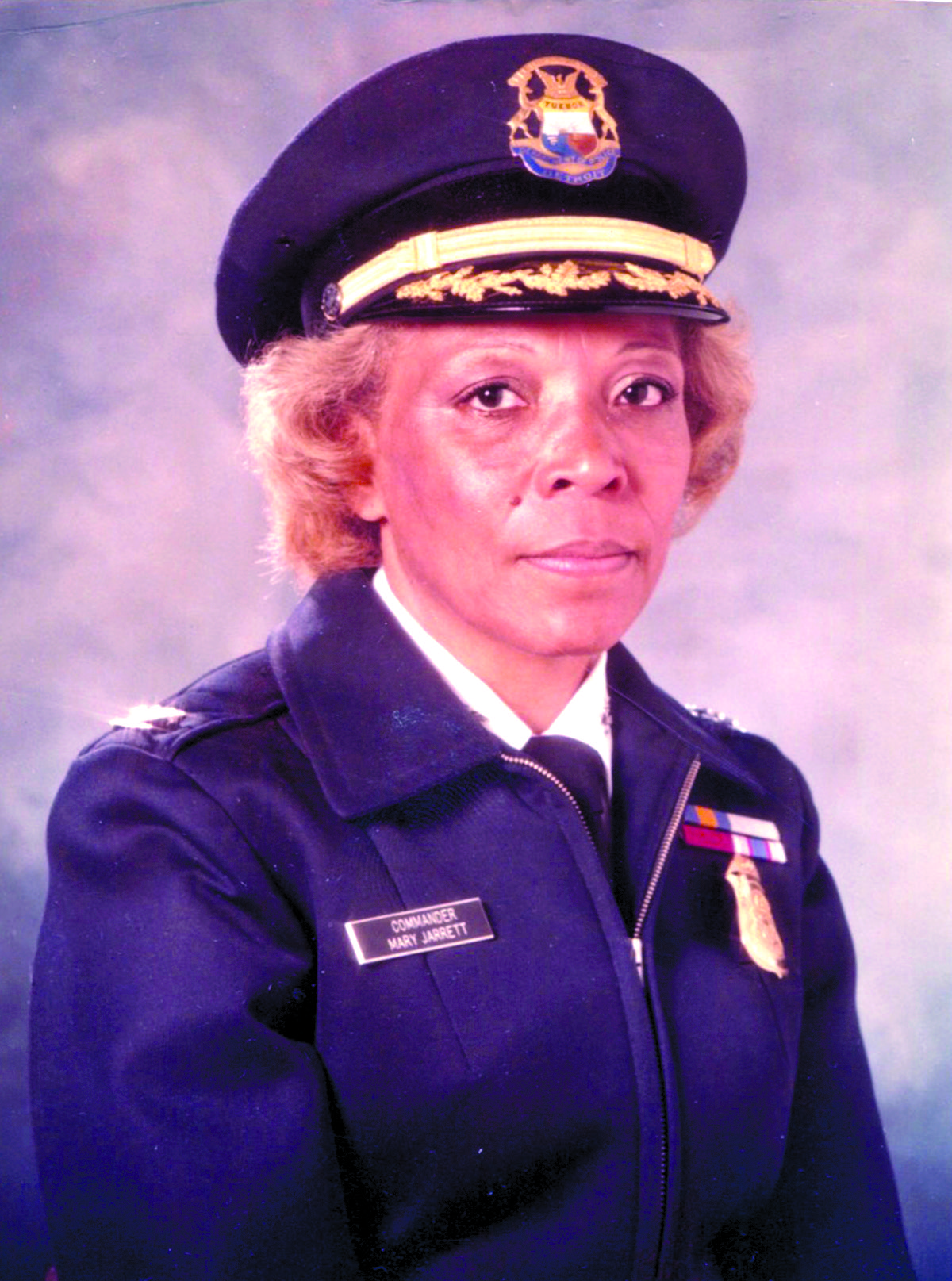
Mary Jarrett Jackson, the first female deputy police chief in Detroit history – and the first female chief of any major department in the world – who was appointed by Mayor Coleman Young in 1986, was already a veteran of the Detroit Police Department when she got the nod for the promotion. After applying for a position on the DPD in 1957, she was hired one year later in 1958. This means that by the time Young had been elected as the city’s first black mayor in 1974, Jackson had already been toiling away inside the belly of the beast for close to two decades. Young campaigned on police brutality, specifically the brutality exercised by the DPD’s STRESS unit, vowing to disband STRESS and integrate the DPD if elected. Young fulfilled both promises.
By the time Jackson made history she had served for close to 30 years inside a department that had gained a nationwide reputation for how harshly it despised the city’s residents who looked like her.
Think about that for a moment. A black woman working as a Detroit police officer inside a predominantly white male police force during one of the most racially charged and violent periods of Detroit history when some of the most vicious acts of violence perpetrated against the black community were being committed by those same white male police officers. Listening to them brag day after day about how many black people they had beaten up that day, then looking over at Jackson to make sure she heard them. Then laughing about it.
Wayne State University Police Chief Tony Holt was a black youth of only 17 years when the city erupted into chaos, but much of what he saw and experienced during those five days, and in the ensuing years, made him believe that the best way to make things better for the next generations was to become a police officer himself.
“What’s scary is my father worked at Kelsey Hayes plant. They had the curfew and I almost couldn’t sleep because I was worried that something was going to happen to him. Not by thugs but by the police or the National Guard, because they had checkpoints and they were stopping people,” said Holt. “I was really worried. I would say ‘Dad, can you call once you get to work, let us know you’re OK?’ It was on McGraw and Livernois where the plant was.”
Most who know the full story and background of the ‘67 Detroit riot/rebellion are pretty much agreed that the confrontation between police and community that began outside a ‘blind pig’ near 12th Street and Clairmount on a hot July night and then spread like a brushfire into five days of violence, looting and brutality, had much to do with the bottled up anger and rage of a victimized population fed up with enduring routine brutality and mistreatment from their own police force that technically was supposed to be protecting them from harm. Add to that the routine racism and discrimination experienced on a near daily basis from far too many of Detroit’s remaining non-uniformed white community and the recipe for an explosive cocktail became an inevitability.
In their own words, because they tell their own stories the best, two of Detroit’s finest recall their experiences from an earlier Detroit that dramatically shaped their lives and careers.
Mary Jarrett Jackson
“I applied in 1957, you know, they had a quota. And they had a women’s division and all of the women allegedly had to go to that division. I applied but I didn’t even want to be a policeman. I wanted to get in the lab, but when I went to apply for the lab, there were three policemen behind the desk, all white, and they just fell out laughing. And then when they finally got themselves together, they said you can’t get in the lab unless you’re a police officer. Which wasn’t true. There was a white civilian male there but, you know, that was to discourage me. But my dad always told me whatever hurdle they give you, take whatever you can and try to get over it.
“So I said, well then give me an application for a police officer. I didn’t intend to fill it out. I had a child, and I didn’t know what a police officer would have to do, but when I went and talked to my Dad, he said this is your first hurdle. Just fill out the application and take the test. And so I did.

“I wasn’t hired until 1958 because the women’s division never hired more than 12 black out of the 80 female officers and they had their quota so I had to wait until 1958 when one of the sergeants retired before I could even be considered.”
“The police department was always hostile to all blacks. They just got ugly with anybody, anybody who was out to have a good time. The police were just out harassing. Just because they could.”
How was it for black officers?
“They had to converse with each other. They’d come in and say, ‘How many niggers did you hit today? Beat up today? Meaning for me to hear it because I was the only one there. But I just never reacted to it, I didn’t say anything. I just, you know, would let it slide off my back and go in the bathroom later if I felt like I was really upset and cry and get it out of my system. But go back when I was better and try to act like nothing was wrong with me. Because you can’t let people get the better of you.
As for how she was treated by other black people in the community, “I never had a problem. I never fired my gun in 35 years. They [black people] respected us I think because we treated them like they were human beings.”
Chief Anthony Holt
“Actually when it [the riot] broke out, I was on Dexter and Elmhurst, and it had just broke out on 12th Street. And I remember I had a ’61 Impala with my two cousins, and we were riding around. But what’s funny, you could feel the tension in the air. It was almost like when you’re outside and you can tell ‘Oh we got a storm comin’ ‘ And you can feel it? It was that same same feeling the night of and the day after they did that raid on the blind pig.”
“It’s hard to describe; you’re driving around, and you know something is gonna happen. That’s what I felt, and I was only 17 at that time. I was at Wayne (State University) because I got into Wayne when I was 16. And I was riding around and I said, ‘man, something is not right here.’ It was just like a series of explosions. There were more people out than you usually see out. 12th Street was like a mini-downtown. It always had a lot of people out. There were nightclubs, jazz clubs, girls worked the street, the players were out there. But Dexter wasn’t always like that. But you saw all these people out [on Dexter]. And I said, man did something happen? Is something going on? It was just like a chain reaction. I saw this guy throw a brick through the window of this furniture store, and people started going in and grabbing stuff. ” This was the morning of the riot. “They raided the blind pig that night.”

“But then, how the word spread like that I don’t know.”
Did this influence you wanting to become a cop?
“It did because there was very few African American police officers visible. Ike McKinnon was an officer at that time, Willie Bell, and a few others. But none really in a position of authority. And that’s when the Big Four was out. They had a west side crew and an east side crew. That was where they had one uniformed and three plain clothes officers driving around in a car. “They were big guys; they were supposed to handle felonies and above. Serious crimes. Police were pretty tough back then. There was some pretty brutal stuff back then.”
Riot or rebellion?
“I think it was a rebellion, but it was not a race riot. It was definitely not a race riot because when I was driving down Dexter, when I saw the stores being looted? I saw white people pulling their car over and running in. They had a chain and passing stuff out. And it was white and black. Oh yeah. I actually saw – and people will dispute this – white people come who didn’t live in Detroit participating in the looting. It was a free-for-all. It was a rebellion, but I didn’t see it as a racial rebellion.
“I was out in the street when this was going on. I actually had folks ask me, ‘Hey, can you go get me some stuff’. Neighbors.
“And it wasn’t all the racial tension you thought because the community was taking food to them. I lived across the street from the fire house and my mother would cook food and say ‘take this over to the firemen.’ Because they were being pelted with bottles and stuff. And when they would go out on runs, I would see neighbors take chairs and they would sit in front of the firehouse and make sure nobody went in there. During the riots. I lived right across the street.”

